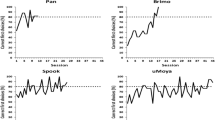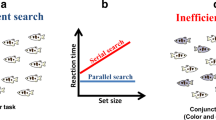Abstract
The ability to visually complete partly occluded objects (so-called “amodal completion”) has been documented in mammals and birds. Here, we report the first evidence of such a perceptual ability in a fish species. Fish (Xenotoca eiseni) were trained to discriminate between a complete and an amputated disk. Thereafter, the fish performed test trials in which hexagonal polygons were either exactly juxtaposed or only placed close to the missing sectors of the disk in order to produce or not produce the impression (to a human observer) of an occlusion of the missing sectors of the disk by the polygon. In another experiment, fish were first trained to discriminate between hexagonal polygons that were either exactly juxtaposed or only placed close to the missing sectors of a disk, and then tested for choice between a complete and an amputated disk. In both experiments, fish behaved as if they were experiencing visual completion of the partly occluded stimuli. These findings suggest that the ability to visually complete partly occluded objects may be widespread among vertebrates, possibly inherited in mammals, birds and fish from early vertebrate ancestors.




Similar content being viewed by others
References
Aust U, Huber L (2006) Does the use of natural stimuli facilitate amodal completion in pigeons? Perception 35:333–349
Bakin JS, Nakayama K, Gilbert CD (2000) Visual responses in monkeys areas V1 and V2 to three-dimensional surface configuration. J Neurosci 20:8188–8198
Braithwaite VA (2006 ) Cognitive ability in fish. Fish Physiol 24:1–37
Bshary R, Wickler W, Fricke H (2002) Fish cognition: a primate’s eye view. Anim Cogn 5:1–13
Cavoto B, Cook RG (2007) The contribution of monocular depth cues to scene perception in pigeons. Psychol Sci 17:628–634
Cerella J (1980) The pigeon’s analysis of pictures. Pattern Recogn 12:1–6
Clara E, Regolin L, Vallortigara G, Zanforlin M (2006) Domestic chicks perceive stereokinetic illusions. Perception 35:983–992
Di Pietro NT, Wasserman EA, Young ME (2002) Effects of occlusion on pigeon’s visual object recognition. Perception 31:1299–1312
Deruelle C, Barbet I, Dépy D, Fagot J (2000) Perception of partly occluded figures by baboons (Papio papio). Perception 39:1483–1497
Forkman B (1998) Hen use occlusion to judge depth in a two-dimensional picture. Perception 27:861–867
Forkman B, Vallortigara G (1999) Minimization of modal contours: an essential cross-species strategy in disambiguating relative depth. Anim Cogn 2:181–185
Fujita K (2001) Perceptual completion in rhesus monkey (Macaca mulatta) and pigeons (Columba livia). Percep Psychop 63:115–125
Grossberg S, Mingolla E (1985) Neural dynamics of form perception: Boundary completion, illusory figures, and neon colour spreading. Psychol Rev 92:173–211
Jarvis ED, Güntürkün O, Bruce L, Csillag A, Karten HJ, Kuenzel W, Medina L, Paxinos G, Perkel DJ, Shimizu T, Striedter G, Wild M, Ball GF, Dugas-Ford J, Durand S, Hough G, Husband S, Kubikova L, Lee D, Mello C V, Powers A, Siang C, Smulders TV, Wada K, White S A, Yamamoto K, Yu J, Reiner A, Butler A B (2005) Avian brains and a new understanding of vertebrate brain evolution. Nature Rev Neurosci 6:151–159
Kanizsa G (1979) Organization in Vision. Praeger, New York
Kanizsa G, Renzi P, Conte S, Compostela C, Guerani L (1993) Amodal completion in mouse vision. Perception 22:713–721
Kellman PJ, Shipley TF (1991) A theory of visual interpolation in object perception. Cogn Psychol 23:141–221
Kellman PJ, Guttman S,Wickens T (2001) Geometric and neural models of contour and surface interpolation in visual object perception. In: Shipley TF, Kellman PJ (eds) From fragments to objects: segmentation and grouping in vision. Elsevier, New York pp 183–245
Kellman PJ, Garrigan P, Shipley TF (2005) Object interpolation in three dimensions. Psychol Rev 112:586–609
Lazareva OF, Wasserman EA, Biederman I (2007) Pigeons’ recognition of partially occluded objects depends on specific training experience. Perception (in press)
Lea SEG, Stater AM, Ryan CME (1996) Perception of object unity in chicks: a comparison with human infant. Infant Behav Develop 19:501–504
Meyer MK, Wischnath L, Foerster W (1985) Lebendgeba¨rende Zierfishe: Arten der Welt [Viviparous ornamental fishes: Species of the world]. Mergus Verlag, Melle
Michotte A, Thinés G, Crabbé G (1964) Les complements amodaux des structures perceptives. Publications Universitaires de Louvain, Louvain
Nagasaka Y Osada Y (2000) Subjective contours, amodal completion and transparemcy in animals. Jap J Anim Psychol 50:61–73
Nagasaka Y, Hori K, Osada Y (2005) Perceptual grouping in pigeons. Perception 34:625–632
Nagasaka Y, Lazareva OF, Wasserman EA (2007) Prior experience affects amodal completion in pigeons. Perception (in press)
Nieder A (2002) Seeing more than meets the eye : processing of illusory contours in animals. J Comp Physiol A 188:249–260
Okanoya K, Takahashi M (2000) Shikaku-teki hokan e no seitaigaku-teki apuroochi (Ecological approach to visual completion). Kokoro no hattatsu: ninchi-teki seicho no kikoo 1999 (Reports of the Grant-in-aid for Scientific Research for Priority Areas, pp 34–41)
Orger MB, Smear MC, Anstis SM, Baier H (2000) Perception of Fourier and non-Fourier motion by larval zebrafish. Nat Neurosci 11:1128–1133
Osada Y, Schiller P H (1994) Can monkeys see objects under condition of transparency and occlusion? Invest Ophthal Visual Sci 35:1664
Palmer SE (1999) Organizing objects and scenes. In: Palmer SE (ed) Vision science–photons to phenomenology. The MIT Press, Cambridge pp 254–310
Regolin L, Vallortigara G (1995) Perception of partly occluded objects by young chicks. Percep Psychophys 57:971–976
Regolin L, Marconato F, Vallortigara G (2004) Hemispheric differences in the recognition of partly occluded objects by newly hatched domestic chicks (Gallus gallus). Anim Cogn 7:162–70
Sato A, Kanazawa S, Fujita K (1997) Perception of objects unity in chimpanzees (Pan Troglodytes). Jap Psychol Res 39:191–199
Sekuler AB, Palmer SE (1992) Perception of partly occluded objects: a microgenetic analysis. J Exp Psychol: Gen 121:95–111
Sekuler AB, Lee JAJ, Shettleworth SJ (1996) Pigeons do not complete partly occluded figures. Perception 25:1109–1120
Sovrano VA, Bisazza A, Vallortigara G (2002) Modularity and spatial reorientation in a simple mind: Encoding of geometric and nongeometric properties of a spatial environment by fish. Cognition 85:51–59
Sovrano VA, Bisazza A, Vallortigara G (2003) Modularity as a fish views it: conjoining geometric and nongeometric information for spatial reorientation. J Exp Psychol Anim Behav Process 29:199–210
Sovrano VA, Bisazza A, Vallortigara G (2005) Animals’ use of landmarks and metric information to reorient: Effects of the size of the experimental space. Cognition 97:121–133
Sovrano VA, Bisazza A, Vallortigara G (2007) How fish do geometry in large and in small spaces. Anim Cogn 10:47–54
Spelke ES (2000) Core knowledge. Am Psychol 55:1233–1243
Spelke ES (2003) What makes us smart. Core knowledge and natural language. In: Gentner D, Goldin-Meadow S (eds) Language in mind. Advances in the study of language and thought. MIT Press, Cambridge, pp 277–311
Sugita Y (1999) Grouping of image fragments in primary visual cortex. Nature 401:269–272
Ushitani T, Fujita K (2005) Pigeons do not perceptually complete partially occluded photos of food: an ecological approach to the “pigeon problem.” Behav Process 69:67–78
Vallortigara G (2004) Visual cognition and representation in birds and primates. In: Rogers LJ, Kaplan G (eds) Vertebrate comparative cognition: are primates superior to non-primates? Kluwer, Dodrecht, pp 57–94
Vallortigara G (2006) The cognitive chicken: visual and spatial cognition in a non-mammalian brain. In: Wasserman EA, Zentall TR (eds) Comparative cognition: experimental explorations of animal intelligence. Oxford University Press, Oxford pp 41–58
Vallortigara G, Zanforlin M (1989) Place and object learning in chicks (Gallus gallus domesticus). J Comp Psychol 103:201–209
Vallortigara G, Tommasi L (2001) Minimization of modal contours: an instance of an evolutionary internalized geometric regularity? Brain Behav Sci 24:706–707
Vallortigara G, Regolin L (2002) Facing an obstacle: lateralization of object and spatial cognition. In: Andrew RJ, Rogers LJ (eds) Comparative vertebrate lateralization. Cambridge University Press, Cambridge pp 383–444
Vallortigara G, Regolin L (2006) Gravity bias in the interpretation of biological motion by inexperienced chicks. Curr Biol 16:279–280
Vallortigara G, Zanforlin M, Compostella S (1990) Perceptual organization in animal learning: cues or objects? Ethology 85:89–102
Vallortigara G, Regolin L, Marconato F (2005) Visually inexperienced chicks exhibit a spontaneous preference for biological motion patterns. PLoS Biol 3(7):1312–1316 (e208)
Acknowledgments
All the experiments reported comply with the guidelines for the ethical treatment of animals in behavioral research and teaching (Animal Behaviour 2003) and with current European Community and Italian laws.
We wish to thank Professor Giorgio Vallortigara for reading and commenting on this manuscript, Dr Marco Dadda for technical help with the apparatus, Paola Cicia and Alice Perseghin for help with training the animals, and three anonymous reviewers for thoughtful comments on the manuscript.
Author information
Authors and Affiliations
Corresponding author
Rights and permissions
About this article
Cite this article
Sovrano, V.A., Bisazza, A. Recognition of partly occluded objects by fish. Anim Cogn 11, 161–166 (2008). https://doi.org/10.1007/s10071-007-0100-9
Received:
Revised:
Accepted:
Published:
Issue Date:
DOI: https://doi.org/10.1007/s10071-007-0100-9




